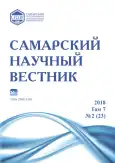Ecological status assessment of microbic population from cespitose-podsolic soil basic saprothrophic microbic pool at the Inzensky field diatomite biochemical destruction
- Authors: Kozlov A.V.1, Kulikova A.H.2, Uromova I.P.1
-
Affiliations:
- Minin Nizhny Novgorod State Pedagogical University
- Ulyanovsk State Agrarian University named after P.A. Stolypin
- Issue: Vol 7, No 2 (2018)
- Pages: 68-72
- Section: 03.02.00 – General Biology
- URL: https://journals.rcsi.science/2309-4370/article/view/21724
- DOI: https://doi.org/10.17816/snv201872113
- ID: 21724
Cite item
Full Text
Abstract
The following paper considers reaction of the saprothrophic and ammoniphycal microbic populations, allocated from the cespitose-podsolic sandy loamy soil of the Nizhny Novgorod Region, to the Inzensky field diatomite substance. On this basis the ecological status of these microorganisms in relation to the studied high-siliceous breed is estimated subsequently. 7-day accumulative cultures of general saprothrophic and ammoniphycal bacteria were used in the study. Living cells were emitted from the cespitose and podsolic soil selected from the Borsky district field «Elitkhoz» by the standard rules in microbiological biotechnology. The result of the research was 30-day dynamics of the breed culture system regarding change of living cells number and proteolytic enzymatic activity of bacterial suspension at biochemical degradation of diatomite substance. The described reaction of microbic complexes in the form of positive dynamics of number and protease activity demonstrates direct destruction interaction of bacterial cultures with diatomite breed that, in turn, can assume their active reaction with this breed and organic substance of the soil with the subsequent release in soil solution of various nutritious elements and in general – stabilization of bacterial L-strategists in the general ecological status of soil microbiocenosis.
Full Text
##article.viewOnOriginalSite##About the authors
Andrey Vladimirovich Kozlov
Minin Nizhny Novgorod State Pedagogical University
Email: a_v_kozlov@mail.ru
candidate of biological sciences, associate professor of Ecological Education and Rational Environmental Management Department
Russian Federation, Nizhny NovgorodAlevtina Hristoforovna Kulikova
Ulyanovsk State Agrarian University named after P.A. Stolypin
Email: agroec@yandex.ru
doctor of agricultural sciences, head of Soil Science, Agrochemistry and Agroecology Department
Russian Federation, UlyanovskIrina Pavlovna Uromova
Minin Nizhny Novgorod State Pedagogical University
Author for correspondence.
Email: uromova2012@yandex.ru
doctor of agricultural sciences, professor of Biology, Chemistry and Biological and Chemical Education Department
Russian Federation, Nizhny NovgorodReferences
- Бочарникова Е.А., Матыченков В.В., Матыченков И.В. Кремниевые удобрения и мелиоранты: история изучения, теория и практика применения // Агрохимия. 2011. № 7. С. 84-96.
- Козлов А.В., Куликова А.Х., Яшин Е.А. Роль и значение кремния и кремнийсодержащих веществ в агроэкосистемах // Вестник Мининского университета. 2015. № 2 (10). С. 23.
- Матыченков В.В., Бочарникова Е.А., Аммосова Я.М. Влияние кремниевых удобрений на растения и почву // Агрохимия. 2002. № 2. С. 86-93.
- Козлов А.В., Куликова А.Х. Влияние высококремнистых пород на структуру, численность и ферментативную активность целлюлозосапротрофного микробного пула дерново-подзолистой почвы в условиях выращивания озимой пшеницы и картофеля // Вестник Ульяновской государственной сельскохозяйственной академии. 2016. № 1 (33). С. 56-65.
- Козлов А.В., Куликова А.Х., Уромова И.П. Влияние высококремнистых пород (диатомита, цеолита и бентонитовой глины) на активность олиготрофного и автохтонного микробного пула дерново-подзолистой почвы // Вестник Томского государственного университета. Серия: Биология. 2017. № 4 (40). С. 44-65.
- Матыченков В.В. Роль подвижных соединений кремния в растениях и в системе почва-растение: автореф. дис. … д-ра биол. наук. Пущино, 2008. 34 с.
- Дистанов У.Г. Минеральное сырье. Опал-кристобалитовые породы: справочник. М.: Геоинформарк, 1998. 27 с.
- Практикум по микробиологии / под ред. А.И. Нетрусова. М.: Изд. Центр «Академия», 2005. 608 с.
- Безбородов А.М., Квеситадзе Г.И. Микробиологический синтез. СПб.: Проспект Науки, 2011. 144 с.
- Грачева И.М., Иванова Л.А. Биотехнология биологически активных веществ. М.: Элевар, 2006. 453 с.
- Хазиев Ф.Х. Методы почвенной энзимологии. М.: Наука, 2005. 252 с.
- Лысак Л.В., Добровольская Т.Г., Скворцова И.Н. Методы оценки бактериального разнообразия почв и идентификации почвенных бактерий. М.: МАКС Пресс, 2003. 120 с.
- Доспехов Б.А. Методика полевого опыта (с основами статистической обработки результатов исследований). М.: ИД Альянс, 2011. 352 с.
- Добровольская Т.Г., Головченко А.В., Лысак Л.В., Зенова Г.М. Физикохимия и биология торфа. Методы оценки численности и разнообразия бактериальных и актиномицетных комплексов торфяных почв. Томск: Издательство Томского ГПУ, 2010. 97 с.
Supplementary files








